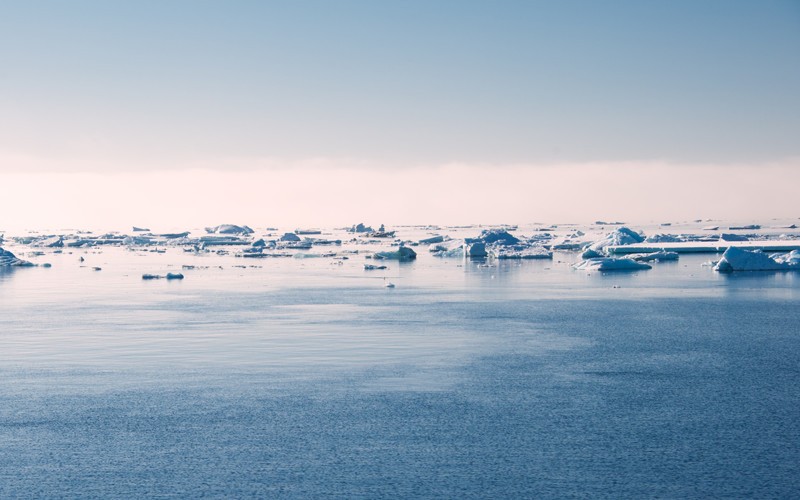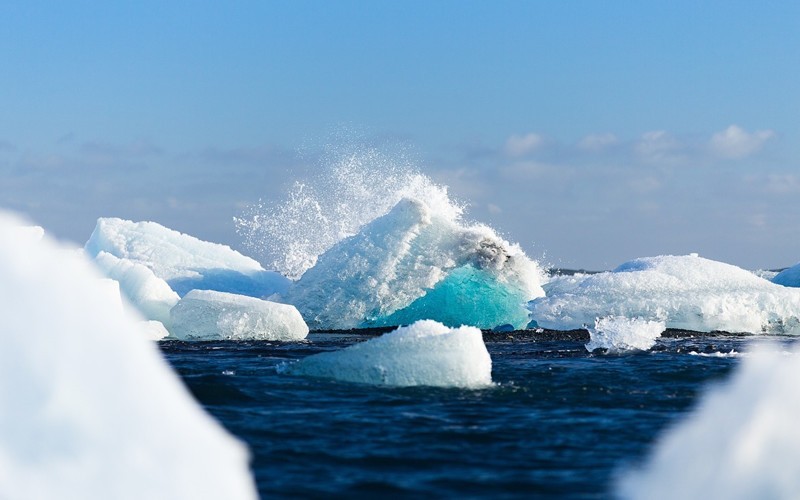Antarctic Ocean
The Antarctic Ocean, or the Southern Ocean, is the last ocean to be
designated as such. Indeed, not all countries and researchers recognize
it even though the U.S. Board on Geographic Names and the International
Hydrographic Organization recognizes it already. Its limits were defined
by this organization in 2000 but need confirmation from most oceanic
agencies and administrations.
It differs from the other oceans as it is the only one that surrounds
a continent. It comprises the waters located in the southern
hemisphere, whose boundaries are the Antarctic Convergence or latitude
60° south and the Antarctica coast. It covers all the 360° of longitude.
It connects the principal southern oceanic basins as well as the sea
surface with deeper layers of water.
The Antarctic Ocean, has an area of about 21.96 million square kilometers and includes:
– the Weddell Sea,
– the Lazarev Sea,
– the Riiser-Larsen Sea,
– the Amundsen Sea,
– the Cosmonauts Sea,
– the Cooperation Sea,
– the Davis Sea,
– the Bransfield Strait,
– part of the Drake Passage,
– the D’Urville Sea,
– the Somov Sea,
– part of the Scotia Sea, and
– the Ross Sea.
– the Lazarev Sea,
– the Riiser-Larsen Sea,
– the Amundsen Sea,
– the Cosmonauts Sea,
– the Cooperation Sea,
– the Davis Sea,
– the Bransfield Strait,
– part of the Drake Passage,
– the D’Urville Sea,
– the Somov Sea,
– part of the Scotia Sea, and
– the Ross Sea.
This ocean has the largest ocean current, called the Antarctic Circumpolar Current.
Properties of the Antarctic Ocean.
This ocean has the largest ocean current, called the Antarctic
Circumpolar Current, and since it connects the Pacific, Atlantic, and
Indian Ocean basins, it influences the climate of the entire planet.
It takes 135-145 million cubic meters of water per second from west to
east along 20,000 Antarctic kilometers at a speed of 0.5 meters per
second. This current distributes heat and influences rainfall patterns
and temperatures.
It has an average depth of 4000-5000 meters and touches around 17,968
kilometers of Antarctic coastline. A continental shelf about 260
kilometers wide and a maximum of 2600 kilometers lies beneath this
ocean.
Its temperature ranges between 10°C and -2 °C,
but it has the strongest winds and waves in the world, as the
temperature of the ice contrasts the open ocean. During winter, the sea
freezes at a latitude 65° south at the Pacific and a latitude 55° south
in the Atlantic Ocean sector. During winter most coastal waters are
frozen except in some areas.
Salinity is lower in the north, near the Antarctic Convergence where
the colder waters flow below, the less cold waters of the Antarctic
convergence. This ocean is a huge deposit of carbon and contains about
50 times more than the atmosphere.
Economic Importance of the Southern Ocean.
Due to the low levels of iron and sunlight, productivity is not high.
It is rich in nutrients and manganese nodules as well as possible oil
and natural gas deposits. It is also home to over 10,000 species, all
perfectly adapted to the weather conditions, such as penguins, squids, whales, seals, krill, and a variety of fish.
Fishing is relatively fruitful, being krill and hake the most caught
species. Between 2006-2007 for example, 126,976 metric tons of these
species were captured.
Illegal fishing affects the sustainability of the sea and reduces the availability of food for other species.
In the Antarctic territory, there are two seaports: McMurdo and
Palmer. Offshore, there are a few anchor points. Not all the waters of
this ocean are navigable due to the presence of ice blocks. Only a few
research boats cross the latitude 60° South since neither private nor
commercial navigation is allowed.
Conservation of the Antarctic Ocean.
The increase of ultraviolet radiation, as a result of the ozone hole,
is a major concern. The ice whiteness reflects the heat and bounces it
back into space, which increases the cold. Some experts think that
ultraviolet radiation is responsible for the reduction of phytoplankton,
the primary link in the food chain. Besides, illegal fishing affects
the sustainability of the sea and reduces the availability of food for
other species.
Some organizations implemented guidelines to diminish the abuse of
its natural resources. For example, the International Whaling Commission
prohibits whaling below latitude 40° South.
Quick facts:
• It covers 20 percent of the surface of all oceans and 4.3 percent of the face of the earth.
• Its narrowest part is the Drake Passage, which has only about 1000 kilometers wide between South America and Antarctica.
• It’s the fourth largest ocean.
• The maximum depth corresponds to the South Sandwich Trench, which is 7,235 meters deep.
• The Antarctic Circumpolar Current carries 150 times more water than the flow of all the rivers in the world.


No comments:
Post a Comment